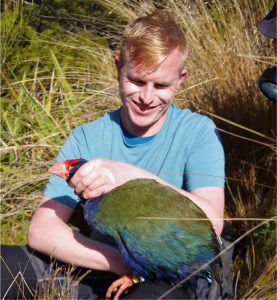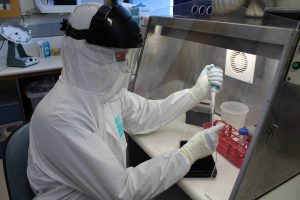Alex Verry’s PhD research field has just broken the one-million-year barrier. Having said that, though, it’s also an area that’s so young that Alex himself wasn’t aware of it before starting at university.
We’re talking ancient DNA here, and the hot-off-the-press news of the oldest aDNA yet to be sequenced – that from million-year-old mammoth teeth preserved in the Siberian permafrost. And while the study of ancient genes traces back to the work of renowned Kiwi scientist (and Otago alumni) Allan Wilson in the 1980s, the subject itself has really taken off in the past few years. It’s only within the last decade or so that researchers have been able to extract aDNA from extinct species ranging from mammoths to cave bears to our own near-relatives, the Neanderthals.
Tragically, it’s also only decades since one species at the heart of Alex’s doctoral study – the New Zealand bush wren – itself disappeared, with the last recorded sighting of this tiny native bird on Kaimohu Island, off Stewart Island, in 1972. Like so many of our treasured endemic species, this endearing creature fell prey to introduced predators like rats and stoats.
Alex’s work, however, allows him to travel back to the time when these wrens were found throughout New Zealand. Indeed, his aDNA detective work allows him to look through the last 20,000 years or so, and especially at the effects of past climate change on populations of New Zealand’s endemic wildlife.
“There’s a strong signal of population structure caused by glaciation,” Alex says. In fact, the genetic evidence suggests the little wren’s evolution was similar to that of our national emblem, the kiwi, with populations contracting and diversifying due to fluctuations in climatic conditions.
And it’s the chance to make an important original contribution to our understanding of New Zealand’s past that has provided excitement, motivation and personal satisfaction.
“No-one had looked at bush wrens before at such a fine scale,” Alex says.
Yet he’s far from a ‘one species researcher, having also worked on other native birds, such as the iconic moa – including taking part in archaeological digs. His willingness to “get involved in things” has seen him out in the field with living taonga, such as takahē, as well as with the preserved remains of their long-departed relatives. For instance, some of his ancient DNA work has resolved a long-standing puzzle on the origins of North Island and South Island varieties of takahē.
“Don’t be afraid to ask – and volunteer” is Alex’s straightforward advice for budding geneticists.
As for his own journey to the soon-to-be-completed PhD, it’ll come as no surprise to learn Alex originally wanted to be a palaeontologist (well, at least when he was a dinosaur-fixated 5-year-old). But his enduring “interest in the natural world” led him to take biology at university, where he stumbled across ancient DNA for the first time.
“What really drew me was listening to a lecturer describing [DNA in] ancient penguin bones,” he recalls. “I thought, ‘This is crazy – can you really do that?’”
As for the future, he’s ready to spread his wings (well, as a bird specialist, why not?!) – possibly with post-doctoral aDNA research in Europe.
Eventually, though, he’d like to end up back home in New Zealand, working in museums or in conservation.
“Or even running my own laboratory.”
Written by Mick Whittle
Images supplied by Alex Verry



